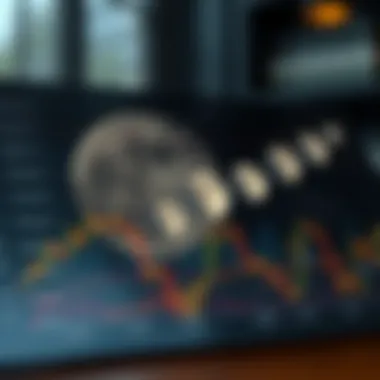Moon Phase Trading Strategies: A Unique Approach


Intro
In recent years, the intersection of astrology and finance has gained traction among traders and investors. The notion that lunar phases can influence human behavior, including financial decisions, is not new. Yet, as unconventional as it may sound, many have started to pay attention to the lunar calendar when formulating their trading strategies. This article takes a deep dive into the realm of moon phase indicator trading, exploring its rich history, scientific underpinnings, and practical applications within today’s financial markets.
The association between the cycles of the moon and market trends can be traced back to ancient civilizations, where traders would rely on celestial events to guide their decision-making. While the idea might seem archaic, modern finance has adopted various alternative trading strategies, including those based on lunar phases. By analyzing correlations between different moon phases and market behaviors, it’s possible to unearth insights that could drive investment decisions in a unique way.
This exploration aims to equip investors, both seasoned and novice, with the knowledge needed to incorporate lunar cycles into their trading practices. By examining case studies, methodologies, and insights from experienced traders, we will discover how to harness the influence of the moon for better trading outcomes.
Key Terms and Definitions
Investment Terminology
Understanding the specific terminology surrounding trading and lunar influences is essential for properly engaging with this subject. Here are some key terms:
- Lunar Phase: Refers to the shape of the illuminated portion of the Moon as it appears from Earth, cycling approximately every 29.5 days.
- New Moon: This phase symbolizes potential and new beginnings, with many traders believing it may influence bullish market trends.
- Full Moon: Often associated with completion, this phase can signal caution or selling pressure in trading contexts.
Detailed Explanations
The moon goes through eight distinct phases, each believed to influence psychological states and decision-making processes:
- Waxing Crescent: Indicating growth and optimism
- First Quarter: A balance between opposing forces, suggesting critical decision-making
- Waxing Gibbous: Anticipation builds as opportunities come closer to fruition
- Full Moon: Represents culmination, leading to potential market volatility
- Waning Gibbous: A period suited for reviewing and consolidating gains
- Last Quarter: Time for reflection and decision reassessment
- Waning Crescent: Conducive to letting go of past trades or strategies and planning new ones
Moon phase trading can be seen as an art and a science, both relying on market emotions and the hard data of price movements.
Expert Insights
Investment Strategies
Harnessing the moon’s cyclical nature can empower investors to craft strategies that align with these periods. For instance:
- Timing Entries and Exits: Placing trades during specific lunar phases can better align with market sentiment.
- Portfolio Adjustments: Investors may consider adjusting their portfolio to reflect the upcoming moon phases, capitalizing on expected volatility.
- Risk Management: Understanding the probable emotional responses driven by lunar phases can assist traders in setting more informed stop-loss levels.
Market Trends Analysis
Historically, some studies indicate that certain stocks or commodities exhibit different behaviors correlating with lunar phases. Examining sectors traditionally linked to consumer behavior, such as retail and luxury goods, might also provide actionable insights. For instance, full moons are often correlated with increased volatility, which can influence traders to hedge against expected fluctuations.
To stay informed about ongoing research and discussions in this niche trading strategy, platforms like Reddit and educational resources from Britannica can serve as valuable references. Exploring market behavior analytics related to lunar cycles on financial websites can further enhance one’s comprehension of this method.
As we further explore the dynamics of moon phase indicator trading, investors can glean more insights into effectively implementing these unique strategies. The dance of the moon and financial markets may result in opportunities where conventional approaches fall short.
Prelude to Moon Phase Indicator Trading
In the ever-evolving world of finance, investors constantly seek strategies that blend conventional analysis with unique indicators. One such approach gaining attention is moon phase indicator trading. This methodology draws connections between the lunar cycles and market behavior, proposing that the phases of the moon can provide insights into potential price movements in various financial instruments. Although it may seem rather unconventional, the allure lies in its intriguing historical implications and distinct psychological factors it may harness.
Historical Context
The history of lunar influences stretches back to ancient civilizations. The Babylonians, utilitarian by nature, were among the first to link the moon's cycles to agricultural and financial systems. They meticulously observed moon phases, believing that certain periods were more favorable for planting crops or embarking on trade. Fast forward to medieval Europe, where astrologers wove lunar patterns into their predictions. Amid the chaos of stock market fluctuations, traders turned their gaze skyward, incorporating the moon's cycles into their strategies.
Today, modern studies have sought to validate this historical perspective through statistical analysis. Some researchers argue that lunar phases correlate with market returns, suggesting that traders who consider this perspective may gain a slight edge. However, others remain skeptical, dismissing it as mere superstition. Understanding this history helps elucidate how moon phase trading, once relegated to myth, now finds its place in contemporary investing methodologies.
The Science Behind Lunar Phases
The science of lunar phases is rooted in astronomy, yet its ramifications reach far beyond the cosmos. The moon undergoes a regular cycle, transitioning through eight distinct phases, each lasting about 29.5 days. The key phases include:
- New Moon: Often symbolizes new beginnings and increased potential, which could inspire bullish sentiment in traders.
- Full Moon: Represents culmination; some believe this can indicate market volatility due to heightened investor emotions.
- Waxing and Waning Phases: These transitional periods signify growth and decline, potentially influencing trades based on momentum.
The psychological aspect of this trading strategy is equally compelling. In the psychological realm, some believe that human behavior is subconsciously tied to lunar cycles. Increased levels of anxiety, optimism, or even impulsiveness could be linked to the full moon. Such emotional fluctuations can heavily affect market sentiment, posing both risks and opportunities for savvy traders.
"The link between lunar cycles and human behavior may well be a double-edged sword in trading; while some find solace in it, others may quickly dismiss it."
In summary, exploring moon phase indicator trading opens a window into the intersection of historical context and scientific principles. By appreciating these facets, traders can understand the broader implications of how lunar phases might inform their strategies. However, as with any method, a prudent investor should balance these insights with established analytical techniques and market dynamics.
Understanding Moon Phases
Understanding the different moon phases is vital for anyone looking to incorporate lunar cycles into their trading strategies. Moon phases are symbolic of change and rhythm, much like the ebbs and flows of the market itself. By grasping the nuances of these phases, traders can potentially enhance their predictive accuracy and timing in the market. In this section, we’ll delve into the significance of new and full moons, as well as the lesser-considered waxing and waning phases, each contributing uniquely to potential trading outcomes.
New Moon and Full Moon


Characteristics of New Moon
The new moon represents beginnings and potential. During this phase, the moon is not illuminated, signifying a time when traders might consider initiating new positions. A popular characteristic of the new moon is its indication of new opportunities, as it often correlates with shifts in market sentiment. Traders might find it beneficial to align their strategies with the lunar calendar during this time, tapping into the fresh energy that surrounds it.
One unique aspect of the new moon is that it can act as a psychological reset for traders. This phase encourages a sense of renewal, often resulting in increased risk-taking. However, traders should also be wary; the flip side to this enthusiasm can be ill-timed investments.
Characteristics of Full Moon
Contrasting the new moon, the full moon is known for completion and reflection. When the moon is fully illuminated, this phase can signal a culmination of market trends. Due to its wide recognition both in popular culture and finance, many traders keep a close eye on the full moon. This phase often brings heightened volatility. Traders may feel compelled to take profits or make significant moves, influencing overall market behavior.
Moreover, a unique feature of the full moon is its potential to reveal overbought or oversold conditions in the market. While this can provide an advantage, it can also lead to rash decisions. Understanding when the full moon arrives might allow traders to plan more strategically.
Waxing and Waning Phases
Waning Crescent
The waning crescent phase signifies a time for reflection and discarding the old before the new cycle begins. It’s characterized by diminishing light, which many traders interpret as a period of caution. The key element here is the potential for closing out positions. For those trading on moon phases, the waning crescent can be used as an optimal time to reassess portfolio allocations and make adjustments.
A unique advantage during this phase is that traders might find opportunities in less visible market shifts. However, the downfall can also be the risk of holding on too long to losing positions.
Waning Gibbous
Following the full moon, the waning gibbous often signals a decreasing momentum in prevailing trends. This phase can indicate a subtle shift that traders need to watch closely. The waning gibbous displays the last growth of lunar light and may suggest that traders should consider exiting positions before a downturn.
The key characteristic of this phase is the opportunity to gauge market conditions. However, failing to act may lead to missed opportunities as trends begin to reverse. Thus, being attentive during this moon phase is crucial.
Waxing Crescent
As the moon begins to grow again, the waxing crescent can signify a budding resurgence in market trends. This phase is often viewed as fertile ground for initiating accumulate positions, as its light represents the potential for new growth. Traders may find optimism during this phase, tapping into a rising market sentiment.
One unique feature to note is that it encourages exploration of new avenues, including investments in emerging sectors. However, the disadvantage lies in the potential overenthusiasm, which could lead to premature commitments.
Waxing Gibbous
The waxing gibbous represents an approaching fullness, suggesting that trends are gaining momentum. Traders often interpret this phase as a signal to ride existing positions toward their peak. The key characteristic here is the build-up leading to market moves that can often provide sweet spots for entry and exit.
The waxing gibbous can dramatically enhance decision-making processes, but there's a fine line—overconfidence can lead to exposures that are unrealistic. Therefore, careful analysis is needed to make the most out of this phase.
"Understanding lunar phases isn’t just about astrology; it’s about tapping into the collective psychology of market participants."
By comprehensively understanding the moon phases, traders can harness insights that may align with their strategies, thus broadening their horizons in terms of market opportunities. Each phase brings specific characteristics that can guide decision-making. Recognizing these fluctuations, whether in enthusiasm or caution, can ultimately create a more effective approach to trading.
Theoretical Basis of Moon Phase Trading
Understanding the theoretical underpinnings of moon phase trading is imperative for grasping how lunar cycles influence market behavior. The concept isn't merely about tracking the moon’s orbit; it dives into a blend of astronomy, psychology, and astrology. By examining these elements, investors can unveil patterns that could enhance their decision-making processes. Incorporating the moon phase theory allows traders to consider not just numbers on a chart but also the emotional and psychological aspects of market dynamics.
Astrological Influences
Astrologers have long believed that celestial bodies affect human behavior and decision-making. The moon, in particular, has significance in astrology, representing emotions and intuition. As traders, the awareness of these astrological influences can sharpen your perspective on market movements. For instance, during a new moon, energies may shift towards new beginnings, potentially signaling market correction or bullish trends. Conversely, a full moon often signifies heightened tensions, which might correlate with increased volatility.
"The moon cycles might echo a trader’s emotional responses, often leading to unpredictable market eruptions."
In practical terms, this astrological lens invites a different approach to market timing. Traders embracing these lunar phases can establish a framework for anticipating market trends with a unique twist. By aligning their strategies with astrological insights, traders might identify optimal moments for entry or exit points based on the celestial calendar.
Psychological Factors in Trading
Psychology heavily drives trading decisions. Understanding the psychological factors at play can give traders an edge. Humans are inherently influenced by emotions: fear, greed, excitement—all can sway market behavior and trading results. During certain moon phases, such as a new moon, traders might feel a surge of optimism, leading to more aggressive investment strategies. On the flip side, anxiety peaks during a full moon, which could result in erratic trading activity or hasty decisions.
Investors should be aware of their psychological tendencies during these lunar phases:
- Feelings of optimism during new moons can lead to over-leveraging.
- Heightened emotional states during full moons might encourage panic selling or impulsive buying.
By incorporating moon phase observations into their trading psychology, investors can cultivate a better understanding of their reactions and, ideally, temper their emotional responses with informed strategies. This dual awareness could potentially enhance overall trading performance, reducing risks associated with emotional trading.
Methodologies in Moon Phase Indicator Trading
Understanding the methodologies in moon phase trading is like having an ace up your sleeve. Traders use these as tools to navigate the unpredictable waters of the financial markets. The surprising part? Many still underestimate the potential that lunar phases hold in shaping market behaviors. This section digs deeper into the frameworks that can set your strategies apart from the mainstream.
Technical Analysis Integration


When incorporating moon phases into trading, the integration of technical analysis plays a key role. This approach allows traders to effectively align lunar cycles with market movements, providing a structured lens through which to interpret data.
Chart Patterns
Chart patterns are not just mere shapes on a screen; they are visual representations of market psychology and behavior over time. Recognizing these patterns can offer insights into potential directional changes in stock prices or other assets. The core characteristic of chart patterns is their predictive ability based on historical price movements. This makes them a popular choice for many traders, especially those looking to incorporate lunar influences.
- Benefits of Chart Patterns:
- They provide clear signals for entry and exit points.
- Familiar patterns like head and shoulders or triangles can represent potential reversals or continuations in a price trend.
However, chart patterns do come with some caveats. They require solid understanding of both past data and market context. A pattern that appears promising during a new moon phase could falter if market conditions suddenly shift. This lack of certainty means that traders must constantly monitor other indicators.
Volume Analysis
Volume analysis is another pillar in the framework of moon phase trading strategies. In simple terms, it measures how many units of a security were traded within a specific time period. High trading volumes often accompany market turning points, making this aspect invaluable. Just like chart patterns, volume gives traders clues about underlying strength or weakness.
- Benefits of Volume Analysis:
- It confirms price movements; for instance, a price rise accompanied by high volume suggests genuine interest among traders.
- It helps identify potential trends; when volume spikes on a full moon, for example, the market might be responding to the lunar phase itself.
On the flip side, it can be deceptive. Sometimes, high volume can occur without significant price change, leading to confusion. Relying solely on volume may also mislead traders into thinking a trend is strong when it's just noise.
Algorithmic Approaches
As we move into the realm of algorithmic approaches, the integration of technology and lunar trading strategies becomes clearer. Algorithmic trading utilizes mathematical models and formulas to execute trades automatically. It takes out much of the emotional decision-making that can cloud human judgment.
Using algorithms in combination with moon phases offers an innovative way to harness lunar cycles. For example, a programmed model might initiate trades during specific lunar events, analyzing historical data to predict future price actions accordingly. While this can enhance efficiency, one must still be cautious; these systems are only as good as the assumptions they are based upon.
In summary, the methodologies in moon phase indicator trading provide a multi-faceted approach. Whether through traditional chart patterns, insightful volume analysis, or advanced algorithmic strategies, traders can potentially unlock profits in ways that conventional models often overlook.
Practical Applications of Moon Phase Trading
The application of moon phases in trading is more than just a novel approach; it brings a distinctive perspective that can be vital for savvy traders. Understanding how lunar cycles might correlate with market movements can provide traders with valuable insights. This practice taps into the blend of psychology, tradition, and speculative trading approaches.
By paying attention to lunar phases, traders can identify potential times for entering or exiting positions, adding an unconventional layer to their strategy. Taking moon phases into account helps in spotting trends that might otherwise go unnoticed in a conventional analysis. Moreover, this method offers a fresh angle when paired with traditional technical analysis, blending the esoteric with solid statistical-based methods.
Identifying Market Trends
Using moon phases to identify market trends involves monitoring specific cycles that could influence price movements. Traders often focus on the new moon and full moon phases as critical indicators, theorizing that these periods can trigger shifts in investor sentiment.
For example, markets might show an uptick in bullish behavior leading up to a full moon, as individuals become more optimistic or action-oriented. Conversely, the new moon could signal a phase of introspection or caution in trading, leading to a market slow down or preventive positioning.
Recognizing these tendencies often requires a blend of intuition and data analysis:
- Timing is key: Noticing when lunar cycles align with market conditions can enhance decision making.
- Volume and volatility correlation: Statistics show that during key lunar phases, trading volume may increase or decrease, correlating with price shifts. This can be observed through careful charting and comparison to historical data.
By integrating these celestial indicators into broader trading models, traders can align their strategies with market psychology and external influences.
Case Studies
Success Stories
Examining success stories within the realm of moon phase trading reveals its potential impact. One noted instance was with traders who focused intensely on historical correlations between lunar shifts and the stock price of tech companies. They found remarkable consistencies aligning with major product launches which often occurred around full moons.
Such success stories highlight the following characteristics:
- Consistency: Identifiable trends over multiple cycles can provide confidence.
- Niche markets: Some traders have even developed a following, leveraging this unique approach to attract clients and enhance trading methodologies.
However, while these stories shine, they come with caveats. Relying solely on moon phases without combining them with other forms of analysis can lead to missed opportunities or increased risk.
Failures and Lessons Learned
Not every attempt at moon phase trading ends on a high note. A poignant case involved a trader who heavily invested based on lunar cycles while ignoring macroeconomic data. When the economy shifted due to unforeseen variables, their positions suffered dramatically.
This instance emphasizes key takeaways:
- Caution against overreliance: Solely adhering to lunar phases can lead to pitfalls, especially if not supported by other fundamental analysis.
- Adaptive learning: Failures should warrant a reassessment of strategies, allowing traders to better incorporate both cosmic insights and traditional metrics.
Experiences of success and failure alike should incite a balanced perspective on lunar phase trading—highlighting the importance of combining psychological, historical, and market data to build robust trading strategies.


"In the realm of trading, knowledge is power, but wisdom is knowing how to interpret that knowledge."
For further reading and a deeper dive into the lunar influences on behavior, you might look into resources like NASA's Lunar Phases or articles discussing similar trading techniques on Reddit. Analyze case studies that provide insights into both victories and losses to build a fuller understanding of this unique trading practice.
Challenges and Limitations
Understanding the challenges and limitations associated with moon phase indicator trading is essential for investors aiming to integrate this unconventional approach into their strategies. While lunar phases provide a unique perspective on market movements, certain factors can influence the effectiveness of applying these indicators in practice. Recognizing these considerations is important when developing realistic trading expectations and better risk management.
Market Volatility
One of the main hurdles that traders encounter in any market is volatility. The financial landscape is often akin to a roller coaster, with prices swinging wildly based on a range of influences like economic indicators, news events, and even social sentiment. In the context of moon phase trading, it's crucial to grasp that lunar cycles don't dictate market movements outright. Instead, they might offer a directional bias or a supplementary layer of analysis.
For example:
- Unexpected News: Suppose a lunar cycle suggests bullish momentum in the stock market during a waxing moon phase. However, if a major geopolitical event occurs simultaneously, the market could react negatively, overshadowing the lunar influence.
- Economic Indicators: In a generally bullish phase, a shockingly poor jobs report can create massive sell-offs, contradicting any bullish projections extrapolated from moon phases. Traders must remain vigilant and ready to adapt to such unpredictable shifts.
Thus, relying solely on moon phases without considering other fundamental and technical indicators could lead to poor decision-making. It’s always recommended to combine lunar insights with a broader view of market trends.
Skepticism in the Trading Community
Another layer of complexity arises from the skepticism that moon phase trading faces within the broader trading community. Many experienced traders and financial analysts view lunar trading strategies with a raised eyebrow, often dismissing them as mere superstition or coincidence. This skepticism stems from several considerations:
- Lack of Empirical Evidence: Critics may point to insufficient empirical research substantiating the efficacy of lunar cycles in predicting market behavior. Other methods, like technical analysis or trend-following strategies, often have a more substantial backing when it comes to documented performance.
- Psychological Bias: Those who adhere to traditional methodologies might perceive moon phase trading as an emotional or psychological crutch. They may argue that traders relying on lunar influence could be subject to cognitive biases, ultimately leading to irrational trading decisions.
Despite this skepticism, some traders swear by lunar phases. They argue that market behavior is often influenced by collective psychology. While it may not be universally accepted, including moon phases as a part of your trading toolbox can appeal to those looking to explore all potential indicators, as long as they perceive it as a complement rather than a replacement for established strategies.
In the world of trading, blending new ideas with proven techniques can be the recipe for success—provided one is equipped to navigate both opportunities and challenges that lie ahead.
Navigating the challenges and limitations of moon phase trading doesn't mean discarding the approach altogether. Instead, recognizing the potential pitfalls and countering the skepticism allows traders to leverage these indicators effectively as part of a well-rounded strategy.
Future of Moon Phase Indicator Trading
As we gaze into the horizon of trading strategies, moon phase indicator trading stands out as an approach that marries ancient observations with modern practices. The future of this method appears promising, given the growing intersection of technology, psychology, and traditional lore in finance. To navigate this evolving landscape, it's key to examine certain elements that will shape its trajectory, the benefits it presents, and the considerations traders should keep in mind.
Emerging Technologies
The influence of emerging technologies on moon phase indicator trading can't be overstated. Tools such as artificial intelligence, machine learning, and big data analytics are revolutionizing how traders interpret and utilize lunar cycles. Here's how these technologies enhance trading strategies:
- Algorithmic Trading: Sophisticated algorithms powered by machine learning can analyze vast amounts of market data alongside lunar phases to identify patterns and suggest optimal trading movements.
- Real-time Data Analysis: With advanced analytics platforms, traders can monitor fluctuations in asset prices relative to lunar phases in real-time, allowing for more informed decisions on the fly.
- Sentiment Analysis Tools: Social media sentiment can also play a role in trading strategies. Emerging sentiment analysis tools can gauge market mood related to lunar cycles, providing additional insights into potential market reactions.
Incorporating these technologies allows for a data-driven approach that can illuminate the nuances of market behavior as influenced by lunar phases. As the saying goes, “knowledge is power,” and having access to real-time insights significantly enhances decision-making.
Continued Research Directions
Research into moon phase indicator trading is not stagnant; instead, it is constantly evolving. For investors and enthusiasts, here are key areas warranting further exploration:
- Behavioral Finance Studies: Investigating psychological patterns that correlate with lunar phases can lead to a deeper understanding of trader behaviors and market movements.
- Longitudinal Studies: More extensive long-term studies could provide solid evidence of the effectiveness of moon phase trading, moving beyond anecdotal success stories.
- Interdisciplinary Approaches: Combining insights from fields such as astrology, psychology, and finance can lead to innovative approaches that could improve trading strategies.
Moon phase indicator trading embodies a blend of intuition and analytical rigor, where past wisdom intersects with the burgeoning capabilities of technology.
Finale
The conclusion serves as a pivotal moment in our exploration of moon phase indicator trading, weaving together the various threads we have uncovered throughout the article. In this section, we'll emphasize the relevance of incorporating lunar phases into trading strategies and reflect on the implications for traders in the financial market.
One of the primary insights is recognizing the cyclical nature of the markets, much like the ebb and flow observed with lunar cycles. Studies suggest that certain phases, particularly the New Moon and Full Moon, can exhibit distinct market behaviors. These observations guide traders towards potential price movements, providing a unique lens through which to evaluate market trends. Being aware of these patterns can be beneficial to traders, as it offers an alternative viewpoint that complements conventional indicators.
Moreover, the psychological aspect of trading is undeniably influenced by larger-than-life forces like the moon. Traders often reflect on this emotional base, added by the magnetic pull of the lunar phases. This understanding creates a foundation for developing strategies that forage beyond traditional economic signals, tapping into more holistic measures. Recognizing that others may have similar sentiments offers traders a sense of confidence in decision-making.
As we close this discourse, it is critical to acknowledge the need for ongoing research. The moon phase's relationship with market dynamics is a growing field of interest, merging the realms of astrology and financial analytical practices. Investors aiming to harness moon phase indicators must constantly adapt and evolve their strategies based on emerging insights and empirical evidence.
"The sky is not the limit; it’s just the beginning of our understanding."
Final thoughts urge traders to balance this unique approach with broader market analyses. While lunar phases can indeed provide fresh perspectives, they shouldn't replace rigorous research and technical analysis. Integrating diverse strategies offers traders the best of both worlds.
Summarizing Key Insights
In sum, moon phase indicator trading emerges as an intriguing methodology in the financial landscape. It transforms the way traders perceive market cycles and emotional cues. The New Moon often heralds a time of new beginnings and can signal potential buying opportunities, while the Full Moon might provoke heightened volatility, indicating moments to reevaluate positions.
Understanding the waxing and waning phases provides further depth, allowing traders to align their strategies with perceived market momentum. As highlighted, adopting a comprehensive trading approach that fits personal risk tolerance is paramount.
Recommendations for Traders
- Stay Informed: Continuously educate yourself about lunar phases and their historical impact on markets. This understanding can help refine your trading plans.
- Experiment with Caution: Implement small tests of moon phase strategies before fully committing resources.
- Diversify Strategies: Use moon phase insights in conjunction with technical and fundamental analysis for a more rounded approach.
- Review and Adjust: Regularly analyze the effectiveness of incorporating lunar phases into your trading activity and make adjustments as necessary.
- Engage with Community: Participate in forums like Reddit or specialized trading platforms to exchange insights and experiences with fellow traders.
In essence, while the moon may seem like a distant celestial body, its influence on market behavior serves as a reminder that we are all interconnected with nature's rhythm. By weaving moon phase insights into your trading strategy, you open avenues that others might overlook, creating potential advantages in the complex world of trading.







